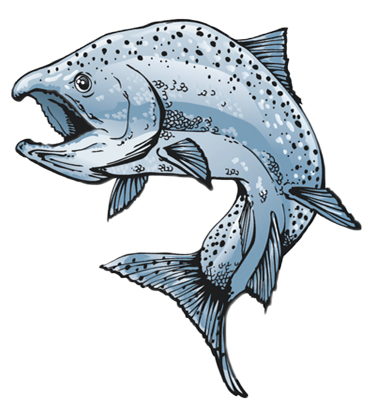Little Fish, Big Deal!
A critical meeting at the mouth of the Columbia River
... and your chance to help
It's hard to envision a creature so tightly entwined in Pacific Northwest history, economics and culture as salmon coursing through the Columbia River basin. Each year, millions of oceanbound juvenile salmon migrate through mountain streams, over dams and past cities and farms. As they pour out of a basin covering an area roughly the size of France, their survival depends to a large degree on the presence of small, schooling fish — commonly called forage fish — where the river meets the sea.
 Forage fish play two major roles for salmon.
Forage fish play two major roles for salmon.
First, schooling fish such as sardines, anchovies, herring and whitebait smelt provide cover against a gauntlet of hungry seabirds, harbor seals and larger fish that will otherwise devour the bite-size juvenile salmon when they arrive at the mouth of the Columbia. In fact, this one point in the salmon journey is crucial in determining the proportion of salmon smolts that will return as spawning adults. It's no coincidence that salmon time the peak of their run for the open ocean in May and June, when forage fish are most abundant. Then, as salmon mature, forage fish become a key food source. Scientists say the extra calories provided by oil-rich forage fish enable salmon to grow larger, produce stronger eggs and improve reproductive success.
Unfortunately, forage fish are an undervalued part of a productive ocean.
As the principal food source for fish, seabirds and marine mammals, forage fish are a critical component of the marine ecosystem. But conventional fisheries management does not account for the needs of salmon or the ecosystem as a whole when setting catch limits for forage fish. As a result, salmon may not get the forage they need or they may not get enough at the critical places and important times that they need it most.
These concerns could be exacerbated if pressure increases to satisfy global demand for these species that are easily netted and processed into fishmeal and oil, most of which goes to feed farmed fish. Forage species caught on the West Coast are largely destined for these types of uses, such as sardines frozen and shipped to Australia to be fed to farmed bluefin tuna. It takes at least 7 pounds of sardines to grow a pound of pen-raised tuna. But there is hope for these important little fish. The Pacific Fishery Management Council has taken a first step toward ensuring a healthy food web by agreeing to develop a fishery ecosystem plan. A strong plan would account for the contribution of forage fish to a balanced and healthy marine environment, and the salmon that rely on it.
Take Action
Tell the Pacific Fishery Management Council that you support a fishery ecosystem plan that explicitly accounts for the importance of forage fish as prey for salmon and other ocean wildlife.
Write the council at [email protected]
Learn more at www.pewenvironment.org/pacificfish











